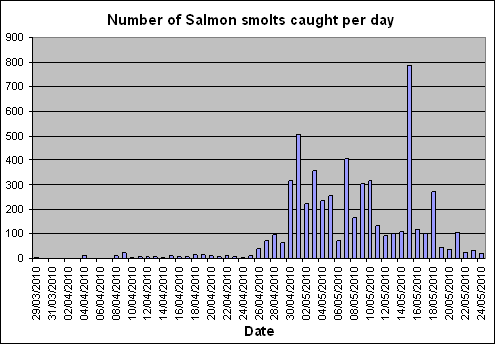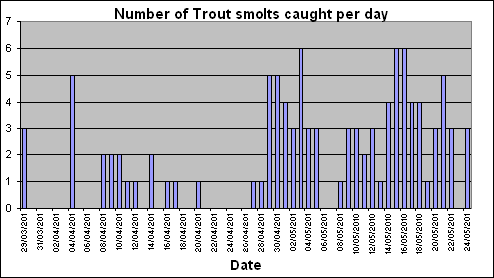The river is getting so low now that the smolt trap is barely turning, although we are still catching fish. I timed the speed of revolution yesterday and it was taking 31 seconds to do one revolution whereas at the start of the project it was taking only 9 seconds. The speed of revolution is determined by the current speed which, at that site is a function of the river height. If the river drops any further the trap may stop revolving completely! However we intend to remove the trap at the end of this week anyway.
Here are graphs showing the daily catch of salmon and sea trout smolts since we started operating the trap in March.


Salmon smolt numbers are dropping but the sea trout smolt catch has remained relatively steady. In the last few days we have seen quite a few salmon smolts with fungus on wounds such as bird damage. If we had seen some proper rain in the last month most of these smolts would have been away to sea by now, avoiding some of the stresses and be in the environment they are adapted to.
I mentioned in an earlier post that we were recording evidence of predator damage. This morning we had two fish with unusual but similar wounds. The salmon smolt pictured below had very clear teeth marks on its belly, with score marks on its flank. The cause, well we are not sure but it looks very like the bite marks you see on Australian surfers when there is a Great White about! I’m not suggesting that there are sharks in the River Ayr but the marks could be the work of a trout or other predatory fish.

Brian Shaw


Facinating data, amazed at numbers of smolts particulary salmon. Has anyone every produced a formula for estimating total smolt production based on the traps results. I would think that the trap would only intercept a small percentage of migrating fish.
Thanks for the comment Michael. We didn’t set out to quantify the run, although that can be done using mark and recapture techniques. However we have carried three individual recapture trials, two earlier in the month and one this week. We re-released 29 marked fish back upstream on Tuesday, two were recaptured yesterday and more could be caught this week. The results of the first two trials were consistent so if this last trial is similar it will give us some confidence if producing an estimate of the total run. Out of interest how many smolts do you think would be produced in the Ayr in a typical year?
Brian Shaw
I am going to get the belt for this, but on the principle that fools rush in I will have a stab at it.
In order to stave of madness I have rounded this figures off.
Assuming ? that 9k salmon spawn in the Ayr system @ 2.2k eggs per fish this gives us a total of 20m eggs laid with a 99% mortality rate we would get [ 200k SMOLTS ]. with a further 95% mortality rate at sea we would get 10k salmon returning. an additional 10% loss to anglers gives 9k salmon spawning.
This would suggest that if the trap catches 5k smolts that would work out at a 2.5% capture rate.
I am of now to look for a high bridge.
Good of you to have a stab anyway Michael!
As I said we didn’t set out to estimate the run but we may be able to give a rough estimate once the trapping is finished. However the smolt run on the River North Esk in Angus has average out at about 180,000 over the last 40 years. The smolt run there is the most intensively monitored in the country and is the best set of data available (http://www.marlab.ac.uk/FRS.Web/Uploads/Documents/FW26Marine%20FH10.pdf ) .
Good though the Ayr is as a salmon river it isn’t quite in the same league as the North Esk so it is probably safe to say that the smolt run, and adult salmon run, will be quite a bit less.
Your estimate for marine mortality are similar that that recorded for the Esk, about 92-95% lost at sea.
The trap is quite far up the mainstem so we aren’t recording any smolts produced in the lower reaches. However, if we feel confident enough to publish a figure for the total smolt run it will appear on here!
There is no fish counter on the river so we don’t know the size of the adult run. Figures I have seen for exploitation rate suggest that anglers take more then 10%. In a relatively small river like the Ayr, with it’s high angling pressure, and beats well up the river I wouldn’t be surprised if the exploitation rate to anglers was around 20%. That means that your rod catch could be produced from a smolt run a good bit smaller then your estimate.
Thanks for posting!
Brian Shaw